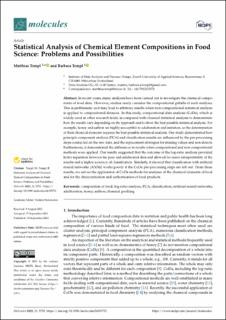Please use this identifier to cite or link to this item:
https://doi.org/10.21256/zhaw-24600Full metadata record
| DC Field | Value | Language |
|---|---|---|
| dc.contributor.author | Templ, Matthias | - |
| dc.contributor.author | Templ, Barbara | - |
| dc.date.accessioned | 2022-03-17T08:06:50Z | - |
| dc.date.available | 2022-03-17T08:06:50Z | - |
| dc.date.issued | 2021-09-23 | - |
| dc.identifier.issn | 1420-3049 | de_CH |
| dc.identifier.uri | https://digitalcollection.zhaw.ch/handle/11475/24600 | - |
| dc.description.abstract | In recent years, many analyses have been carried out to investigate the chemical components of food data. However, studies rarely consider the compositional pitfalls of such analyses. This is problematic as it may lead to arbitrary results when non-compositional statistical analysis is applied to compositional datasets. In this study, compositional data analysis (CoDa), which is widely used in other research fields, is compared with classical statistical analysis to demonstrate how the results vary depending on the approach and to show the best possible statistical analysis. For example, honey and saffron are highly susceptible to adulteration and imitation, so the determination of their chemical elements requires the best possible statistical analysis. Our study demonstrated how principle component analysis (PCA) and classification results are influenced by the pre-processing steps conducted on the raw data, and the replacement strategies for missing values and non-detects. Furthermore, it demonstrated the differences in results when compositional and non-compositional methods were applied. Our results suggested that the outcome of the log-ratio analysis provided better separation between the pure and adulterated data and allowed for easier interpretability of the results and a higher accuracy of classification. Similarly, it showed that classification with artificial neural networks (ANNs) works poorly if the CoDa pre-processing steps are left out. From these results, we advise the application of CoDa methods for analyses of the chemical elements of food and for the characterization and authentication of food products. | de_CH |
| dc.language.iso | en | de_CH |
| dc.publisher | MDPI | de_CH |
| dc.relation.ispartof | Molecules | de_CH |
| dc.rights | http://creativecommons.org/licenses/by/4.0/ | de_CH |
| dc.subject | PCA | de_CH |
| dc.subject | Adulteration | de_CH |
| dc.subject | Artificial neural network | de_CH |
| dc.subject | Chemical profiling | de_CH |
| dc.subject | Classification | de_CH |
| dc.subject | Composition of food | de_CH |
| dc.subject | Honey | de_CH |
| dc.subject | Log-ratio analysis | de_CH |
| dc.subject | Saffron | de_CH |
| dc.subject | Crocus | de_CH |
| dc.subject | Food contamination | de_CH |
| dc.subject | Food technology | de_CH |
| dc.subject | Neural network, computer | de_CH |
| dc.subject | Principal component analysis | de_CH |
| dc.subject.ddc | 006: Spezielle Computerverfahren | de_CH |
| dc.subject.ddc | 664: Lebensmitteltechnologie | de_CH |
| dc.title | Statistical analysis of chemical element compositions in Food Science : problems and possibilities | de_CH |
| dc.type | Beitrag in wissenschaftlicher Zeitschrift | de_CH |
| dcterms.type | Text | de_CH |
| zhaw.departement | School of Engineering | de_CH |
| zhaw.organisationalunit | Institut für Datenanalyse und Prozessdesign (IDP) | de_CH |
| dc.identifier.doi | 10.3390/molecules26195752 | de_CH |
| dc.identifier.doi | 10.21256/zhaw-24600 | - |
| dc.identifier.pmid | 34641296 | de_CH |
| zhaw.funding.eu | No | de_CH |
| zhaw.issue | 19 | de_CH |
| zhaw.originated.zhaw | Yes | de_CH |
| zhaw.pages.start | 5752 | de_CH |
| zhaw.publication.status | publishedVersion | de_CH |
| zhaw.volume | 26 | de_CH |
| zhaw.publication.review | Peer review (Publikation) | de_CH |
| zhaw.author.additional | No | de_CH |
| zhaw.display.portrait | Yes | de_CH |
| zhaw.monitoring.costperiod | 2022 | de_CH |
| Appears in collections: | Publikationen School of Engineering | |
Files in This Item:
| File | Description | Size | Format | |
|---|---|---|---|---|
| 2021_Templ_Chemical-element-composition-food-science.pdf | 509.17 kB | Adobe PDF |  View/Open |
Show simple item record
Templ, M., & Templ, B. (2021). Statistical analysis of chemical element compositions in Food Science : problems and possibilities. Molecules, 26(19), 5752. https://doi.org/10.3390/molecules26195752
Templ, M. and Templ, B. (2021) ‘Statistical analysis of chemical element compositions in Food Science : problems and possibilities’, Molecules, 26(19), p. 5752. Available at: https://doi.org/10.3390/molecules26195752.
M. Templ and B. Templ, “Statistical analysis of chemical element compositions in Food Science : problems and possibilities,” Molecules, vol. 26, no. 19, p. 5752, Sep. 2021, doi: 10.3390/molecules26195752.
TEMPL, Matthias und Barbara TEMPL, 2021. Statistical analysis of chemical element compositions in Food Science : problems and possibilities. Molecules. 23 September 2021. Bd. 26, Nr. 19, S. 5752. DOI 10.3390/molecules26195752
Templ, Matthias, and Barbara Templ. 2021. “Statistical Analysis of Chemical Element Compositions in Food Science : Problems and Possibilities.” Molecules 26 (19): 5752. https://doi.org/10.3390/molecules26195752.
Templ, Matthias, and Barbara Templ. “Statistical Analysis of Chemical Element Compositions in Food Science : Problems and Possibilities.” Molecules, vol. 26, no. 19, Sept. 2021, p. 5752, https://doi.org/10.3390/molecules26195752.
Items in DSpace are protected by copyright, with all rights reserved, unless otherwise indicated.